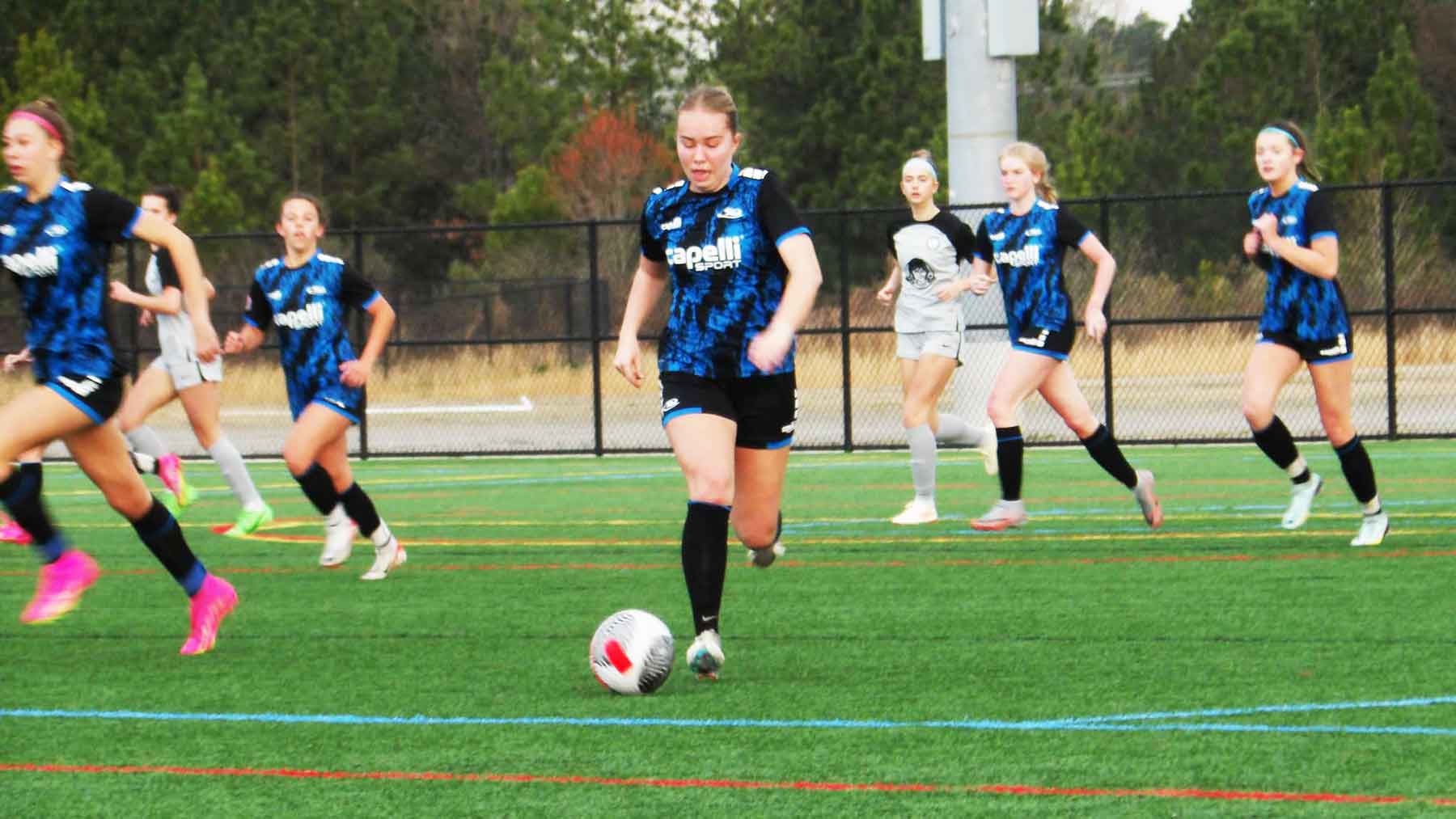Soccer Strategy Breakdown Series: Part 3
Soccer Gameplay Decisions
Learning how to identify a gameplay opportunity isn’t easy and abilities vary widely among young players. Key decisions that players must make include estimating the distance to the goal, knowing when to pass to another teammate, and learning when to kick the ball toward the goal to score. It’s common for young and novice players to feel overwhelmed as soon as they gain control of the ball, causing them to react too early or too late as play progresses in the game.
Before players can learn to make in-game decisions, it’s important to ensure they are thoroughly familiar with the core positions, their roles and responsibilities, and the gameplay options that are open to them. Implementing solid youth soccer tactics in ways that work to their advantage becomes second nature with practice, responsive and expert coaching, and progress achieved through games and post-game feedback.
Northeast Rush’s talented, knowledgeable, and skilled coaches are instrumental in the club’s success both on and off the field. Let’s take a look at valuable soccer strategies and youth soccer tactics that are designed to help young athletes succeed.
Accurate Field Position Judgment
Learning appropriate spacing and passing distances can begin with players as young as six years old. Learning and using good spacing is both a physical and mental skill. By introducing this concept early, players will be able to refine, expand, and improvise using this skill as they grow older and as their gameplay becomes more complex.
Proper spacing is connected to the time that a player needs to receive a pass before taking a second touch — such as a pivot, dribble, pass, or shot — before their opponent can put pressure on them while receiving the pass.
In each age group , most players should be able to make and receive a solid pass over these general distances:
- U6-U7: 5-8 yards
- U8-U10: 8-16 yards
- U11-U12: 16-20 yards
- U13-U16: 16-30 yards
- U16-U18: 16-36 yards
One key benefit of using good spacing while playing on the offense is the ability to prevent a single defender from covering two strikers or midfielders. This offers the attackers more offensive and scoring options when they possess the ball.
Passing the Ball Accurately
Gaining and mastering the ability to pass the ball accurately starts in practice — not only with the team, but also at home to solidify the coach’s instruction. Repetition over time is the key to building physical skills, mental preparation, and confidence in executing accurate passes in the heat of the game against a variety of opponents.
The elements that help young soccer players improve their passing (and receiving) skills include the following:
- Striking and moving with the ball with either foot
- Striking and moving with the ball with different parts of the foot
- Taking a well-balanced stance when passing and receiving the ball
- Controlling the ball with a single touch before immediately moving to a different point on the field
- Pivoting and turning in any direction while passing and receiving the ball
- Receiving and passing the ball without looking at the feet or while looking away from their passing partner
- Keeping a heads-up posture to see the rest of the field allows the player to make continual and instantaneous gameplay decisions
Passing and receiving the ball with skill, accuracy, and confidence opens up a wide variety of opportunities for the players to make quick, appropriate decisions, depending on the game situation in that moment. Learning and improving on every physical and mental skill is an ongoing process that continues throughout a player’s years of soccer experience.
Seeing the Gap Open
When the attacking team sees gaps, or open spaces, behind and between the defending players, they need to move the ball aggressively and directly to get into scoring position. This tactic allows the attackers to use the defenders’ vulnerable positioning to their advantage. The attackers’ ability to pass and receive the ball with their eyes up allows them to close the gap even more quickly before the defenders can close the gaps.
Conversely, defenders should close these gaps between the ball (and the attacker playing the ball) and their goal. By denying that space to the attacking team, defenders can pressure the attackers into turning the ball over to them.
To prepare for gameplay situations where the young player needs to pour on a sudden burst of speed, coaches should ensure that their players are properly nourished and hydrated — and well-conditioned in both sprinting and sustained running. When a full-on sprint is needed, the physical ability to run faster than the opponent — as well as stop or pivot with pinpoint control — is as important as taking advantage of the element of surprise.
To accomplish this goal, many coaches prefer to use players who can move quickly over five to 10 yards rather than those who can run fast over 35 yards. It’s true that a team needs to have both types of players, but a player’s quickness is commonly needed for many different gameplay scenarios.
A player with good short-distance speed can close the distance to the goal quickly, creating a golden scoring chance. As a bonus, a quick player can also create passing angles more rapidly while allowing the team to get into place more quickly.
Having Time
As young soccer players become more adept at recognizing various game situations and making good decisions on the fly, they will typically find that they have more time and space available to them during the game. Players will progress from thinking about what they need to do right now to what they will need to do after that moment in the game.
This kind of situational awareness involves scanning the field, which is commonly known as keeping your head on a swivel. It helps players recognize pressure from the opposition and their own opportunities to defend, attack, and score.
Being able to anticipate the flow of the game — as well as the options available to the opposition — can help the player proactively close the gaps and get to the ball more quickly. By not wasting time to make in-game decisions, players will come to feel as if they have enough time to make the plays they want to make — not the plays that they are forced into making by the opposition.
Know Your Own Ability
The timeless idea that it’s important to “know yourself” is especially true in youth soccer. Because kids progress physically and mentally at very different rates, what one player can do on any given day isn’t always comparable to any of their teammates’ capabilities. Coaches and families must also be aware of each kid’s capabilities to keep them in their own sweet spot for meeting appropriate challenges and overcoming obstacles while avoiding discouragement and hurting their confidence.
If a player has a “big foot” and can boot the ball a long distance but hasn’t developed explosive running speed, coaches can build their confidence by playing them as a back so they can succeed individually while still helping the team. Alternatively, if a player is a quick, short-distance runner but can’t sustain that speed over a longer distance, playing them as an attacker helps them make the most of their current strengths.
Regardless of a player’s physical gameplay strengths, attentive and perceptive coaching can help any player develop solid decision-making skills that complement their strengths. This approach is essential in building players’ confidence starting in their early playing years.
Share This Post

